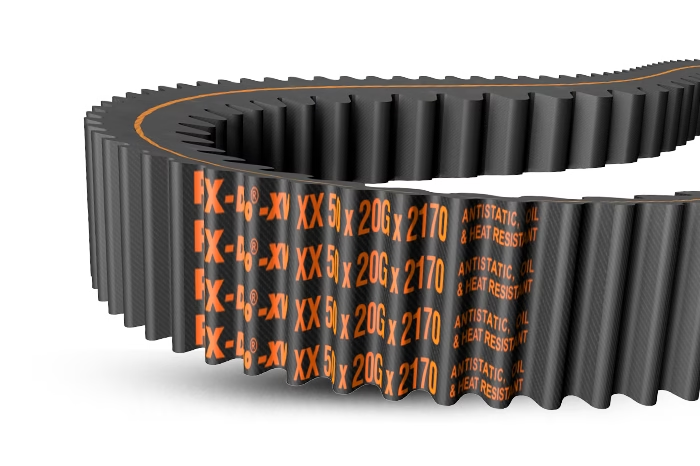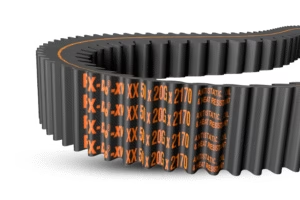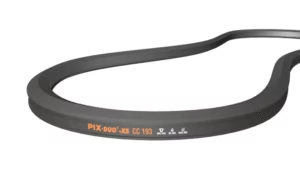The unsung heroes of many machines, V-Belts keep everything functioning properly in the background. However, over time, even the greatest belts may experience problems, such as unexpected breakages or slipping and splitting. You may save downtime and expensive repairs by understanding the root causes of these issues and how to resolve them fast.
1. Belt Slipping
When your V-Belt starts slipping, it loses its grip on the pulley, leading to noise, reduced power, and faster wear.
Causes:
-
Loose belt tension
-
Oily or dusty pulleys
-
Worn-out pulley grooves
Fix:
Clean the pulley surface, remove any oil, and adjust the tension to the recommended level. If the pulley is damaged or too smooth, consider replacing it.
2. Cracked or Broken Belt
A cracked belt is a clear sign of wear and tear. This usually happens when the belt gets too hot or old.
Causes:
-
High operating temperatures
-
Incorrect belt storage
-
Long-term usage without replacement
Fix:
Replace the damaged belt immediately and check the machine’s ventilation or cooling system to prevent overheating.
Note:
If you’re looking to maintain or replace V Belts, it’s always wise to get expert guidance. Pix Trans Thailand offers high-quality solutions for various industrial needs. Contact them to learn more about selecting the right belts and keeping your machinery running at its best.
3. Belt Noise or Squealing
That annoying squealing sound isn’t just irritating it’s your belt calling for help.
Causes:
-
Misaligned pulleys
-
Worn tensioner
-
Over-tightened belt
Fix:
Re-align the pulleys and ensure the belt isn’t too tight. A little adjustment can make the noise disappear instantly.
4. Uneven Belt Wear
If one side of the belt wears out faster than the other, it points to alignment or pulley issues.
Causes:
-
Pulley misalignment
-
Incorrect tension
-
Damaged pulley edges
Fix:
Use a straight edge to check alignment and ensure pulleys are in line. Replace any bent or worn pulleys.
5. Belt Overheating
Excessive heat shortens belt life and weakens its structure.
Causes:
-
High ambient temperature
-
Overloaded drive system
-
Insufficient ventilation
Fix:
Improve airflow around the belt area and ensure the machine isn’t overworked.
Common V-Belt Issues and Quick Fixes
| Problem | Likely Cause | Quick Fix |
|---|---|---|
| Slipping | Loose tension | Adjust belt tension |
| Cracking | Heat or age | Replace with new belt |
| Noise | Misalignment or over-tightening | Realign and retension |
| Uneven wear | Pulley issues | Check and fix pulley alignment |
| Overheating | Overload or poor ventilation | Reduce load and increase airflow |
6. Belt Misalignment
A slightly misaligned pulley might not seem serious, but it can cause vibration, wear, and energy loss.
Fix:
Realign pulleys using a straight edge or laser tool. Always double-check after installing a new belt.
7. Contamination by Oil or Dust
Dust and oil may seem harmless, but they can cause the belt to slip and wear out faster.
Fix:
Clean both the belt and pulleys regularly. Use covers if the machine operates in a dusty or oily environment.
8. Wrong Belt Selection
Sometimes the issue isn’t the belt condition it’s the wrong belt for the job.
Fix:
Always check the manufacturer’s recommendations before buying or replacing a belt. The right size and type make all the difference.
9. Tension Too High or Too Low
Incorrect tension affects performance and lifespan. Too tight causes bearing damage, too loose causes slippage.
Fix:
Use a tension gauge for accuracy. Never guess — it’s better to be precise.
10. Belt Breakage or Sudden Failure
This is the worst-case scenario, but it’s often avoidable.
Causes:
-
Ignoring early warning signs
-
Poor maintenance
-
Belt aging
Fix:
Always replace belts on schedule and inspect regularly to prevent sudden breakdowns.
Preventive Maintenance Checklist
| Inspection Task | Frequency | Why It Matters |
|---|---|---|
| Check tension and alignment | Weekly | Ensures smooth power transmission |
| Clean pulleys and belts | Monthly | Prevents slippage and wear |
| Inspect for cracks or wear | Monthly | Detects early damage |
| Replace old belts | As needed | Avoids costly machine downtime |
Final Thoughts
Every V-Belt problem tells a story usually one about tension, alignment, or neglect. The good news is, most of these issues can be prevented with regular checks and simple fixes. A few minutes of maintenance can save you hours of repair work later.
——————————————————————————————————————————————————————————
Going Beyond Fixes: Building a Strong Maintenance Habit
Fixing a V-Belt problem once is good — but preventing it from happening again is even better. A consistent maintenance routine not only keeps your machines healthy but also saves you time, energy, and unexpected repair costs.
The best part? You don’t need complex tools or deep technical knowledge. Just a few mindful habits can go a long way.
1. Inspect Before You Start
Before switching on a machine, take a quick look at the belt. Does it look dry, cracked, or shiny? These are early signs of trouble. Catching issues before the machine runs helps you avoid belt snapping or performance loss during operation.
Think of it like checking your car tires before a long drive — a few seconds of observation can prevent hours of frustration later.
2. Keep Things Clean and Cool
Dirt, oil, and high heat are the biggest enemies of V-Belts. Even a thin layer of dust can cause a belt to slip, while oil weakens its surface over time.
To maintain belt health:
-
Wipe the pulleys and belt regularly.
-
Avoid storing belts near heat sources.
-
Make sure ventilation fans or cooling systems are working properly.
A clean and cool environment is the secret to long-lasting performance.
3. Use the Right Belt, Always
Not all belts are made equal. Using a belt that’s too wide, narrow, or short can lead to extra strain on the machine and faster wear. Always check the size, type, and load capacity before installation.
A helpful tip is to keep a small log of your belt specifications and replacement dates. That way, when it’s time to change, you’ll have all the details ready — no guessing or wrong fits.
4. Don’t Ignore the Small Noises
If you hear squeaks, rattles, or thuds, don’t just turn up the radio and hope it goes away. Machines often “talk” through these sounds. A squeal could mean the belt is loose; a slap could mean it’s too long or misaligned.
Listening to your machine can prevent bigger breakdowns later — it’s like understanding its language.
5. Create a Maintenance Schedule
Consistency is the key to reliability. Set reminders for belt checks — weekly for tension, monthly for cleaning, and quarterly for replacement checks. You can even hang a simple checklist near the machine for operators to follow.
Over time, this small habit builds a culture of preventive care and keeps everything running smoothly.
The Bottom Line
V-Belts may seem simple, but they play a crucial role in how machines perform. By combining quick fixes with smart prevention, you can double their lifespan and reduce unplanned downtime.
Machines are like people — they work best when cared for regularly. A few minutes of attention today can save you hours of repair work tomorrow.
For more informatic content visit ehomeimprovement


